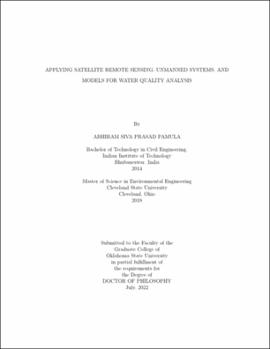| dc.contributor.advisor | Krzmarzick, Mark | |
| dc.contributor.author | Pamula, Abhiram Siva Prasad | |
| dc.date.accessioned | 2023-03-13T20:38:34Z | |
| dc.date.available | 2023-03-13T20:38:34Z | |
| dc.date.issued | 2022-07 | |
| dc.identifier.uri | https://hdl.handle.net/11244/337078 | |
| dc.description.abstract | Transport of soils and sediment by runoff diminish the surface water quality of lakes/reservoirs and shrink reservoir capacity. Nutrients move with transported soil and sediment due to soil erosion by floods and high wind. Nutrients from land management practices such as farming, animal feeding operations, and wastewater treatment stimulate the growth of cyanobacteria in surface water bodies. Excessive nutrient loading or eutrophication with favorable hydrodynamics result in excessive growth of cyanobacteria called Harmful Algal Blooms (HABs). These cyanobacteria sometimes release microcystins which are toxic to humans when consumed. The biological decay of HABs cause ecological dead zones due to depletion of dissolved oxygen while reducing the utility of the reservoirs. From an ecosystem service provision and human health perspective, HABs represent a great water quality threat.Therefore monitoring and modeling the formation of HABs in surface water bodies is important. In freshwater reservoirs of Oklahoma and Kansas, HAB formations and occurrences have increased due to floods, agricultural practices, and rising earth temperatures due to global warming and climate change. In Oklahoma, Grand Lake O' the Cherokees (Grand Lake) had experienced a severe HAB outbreak in 2011. In Kansas, Marion reservoir experiences HAB formation almost every year. These two reservoirs provide an opportunity to study and understand HAB formation, predict them and provide warning advisories. All the in-situ data collected using unmanned systems in the freshwater reservoirs have been used to develop water quality and watershed models to understand the relationship between sediment, nutrient loadings and HAB formations. | |
| dc.format | application/pdf | |
| dc.language | en_US | |
| dc.rights | Copyright is held by the author who has granted the Oklahoma State University Library the non-exclusive right to share this material in its institutional repository. Contact Digital Library Services at lib-dls@okstate.edu or 405-744-9161 for the permission policy on the use, reproduction or distribution of this material. | |
| dc.title | Applying satellite remote sensing, unmanned systems, and models for water quality analysis | |
| dc.contributor.committeeMember | Lampert, David | |
| dc.contributor.committeeMember | Gonzalez, Jorge | |
| dc.contributor.committeeMember | Jacob, Jamey | |
| dc.contributor.committeeMember | Gholizadeh, Hamed | |
| osu.filename | Pamula_okstate_0664D_17824.pdf | |
| osu.accesstype | Open Access | |
| dc.type.genre | Dissertation | |
| dc.type.material | Text | |
| dc.subject.keywords | freshwater ecosystems | |
| dc.subject.keywords | harmful algal blooms | |
| dc.subject.keywords | remote sensing | |
| dc.subject.keywords | water quality modeling | |
| dc.subject.keywords | watershed modeling | |
| thesis.degree.discipline | Civil Engineering | |
| thesis.degree.grantor | Oklahoma State University | |
